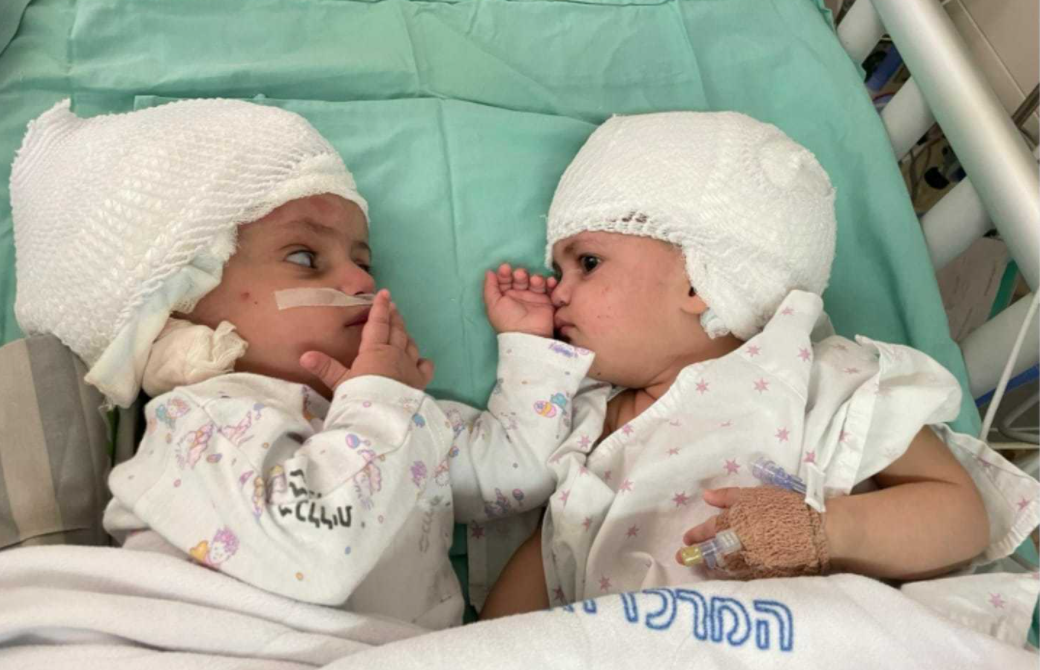‘Unbelievable joy’: Newly separated conjoined twins see each other for the first time
Dr. Isaac Lazar commented on the remarkable moment on Sunday when the girls looked at each other for the first time after a year connected.

[Sept 6, 2021: Nathan Jeffay]
Conjoined twins, newly separated at Soroka University Medical Center in Beersheba, look at each other for the first time, on September 5, 2021. (CREDIT: Soroka University Medical Center in Beersheba)
Doctors in Israel have successfully separated twins conjoined at the head for the first time — and say that after the 12-hour “life or death” operation, both babies are likely to live completely normal lives.
Dr. Isaac Lazar tcommented on the remarkable moment on Sunday when the girls looked at each other for the first time, after a year connected at their heads but unable to see one another, and of the “unbelievable joy” that the parents felt.
“When the nurses brought the babies together, newly separated, they looked at each other, made noises, and gently touched each other — it was beautiful,” Lazar said. “You could see the communication between them, and it was just so special.”
לאחר 16 שעות מטורפות הסתיים ניתוח ראשון בארץ להפרדת תאומות סיאמיות שהיו מחוברות בראשן.
— Igal Malka ?????? (@igal_malka) September 5, 2021
מדהים! pic.twitter.com/zSpnbhNlpE
Every member of the huge medical team, which had been planning the operation since before the babies were born last August, was aware that a single slip could have disastrous consequences. “Any wrong decision could have been the difference between life and death,” said Lazar, director of the Pediatric Intensive Care Unit at Soroka University Medical Center in Beersheba.
“It was so delicate, as the surgery was performed between major blood vessels in the babies’ heads. We all knew that any bleed could have catastrophic consequences.”
But the sophisticated Israeli technology that created 3D models for doctors to practice on, and hundreds of hours of preparation, helped everything go smoothly.
Conjoined twins, photographed before they were separated at Soroka University Medical Center in Beersheba. (CREDIT: Soroka University Medical Center)
“Because the babies couldn’t move their heads for the first 12 months of their lives, there’s a physical handicap, but with the right rehabilitation for their physical and cognitive development, we expect them to catch up with their milestones,” said Lazar, adding there was a “high chance” that they will live normal lives.
Every step on the road to the separation was “massively complex,” he added, even hospitalizing the pair, as intensive care rooms are designed to treat and monitor a single patient but two needed to be hospitalized together here. “We had to double the whole setup, which was very, very hard.”
But this was nothing compared to the operation, which took place at the end of last week. “It was complicated beyond anything one could imagine,” said Lazar. “The babies were connected by the back of their heads in an area where there was no skin and no skull. We had to take action to make them grow more skin.”
Conjoined twins are extremely rare, and every pair is different, so there was limited research that could help. Lazar and his team decided to insert inflatable silicone bags into adjacent parts of their heads, between the scalp and the skull, and start growing skin on top of them.
“Every few days, sterile water was injected into the bags, increasing their volume,” he explained. “This stretched the skin slowly. After five to six months, these water-filled bags and the skin covering them became as big as the babies’ heads, and it looked like each baby had two heads.
“When these ‘balloons’ were ready, the babies could be admitted for surgery. The separation surgery took 12 hours, and ended with doctors dividing into two teams working in two separate operating rooms, performing a reconstruction of the skull of each of the girls and closing the skin.
“After the operation the twins were moved to the ICU, ventilated and sedated. The next day they started breathing on their own and today [Sunday] they met each other for the first time, which was simply amazing.”
Lazar commented: “One of the reasons for doing this now, as early as possible, is to allow normal development, and our hope is that this is now very likely.”
For more international good news stories check out our Global Good News section at The Brighter Side of News.
Like these kind of stories? Get The Brighter Side of News' newsletter.
Tags: #Global_Good_News, #Good_News, #Conjoined_twins, #Medical_News, #Family, #Technology, #The_Brighter_Side_of_News
Joseph Shavit
Head Science News Writer | Communicating Innovation & Discovery
Based in Los Angeles, Joseph Shavit is an accomplished science journalist, head science news writer and co-founder at The Brighter Side of News, where he translates cutting-edge discoveries into compelling stories for a broad audience. With a strong background spanning science, business, product management, media leadership, and entrepreneurship, Joseph brings a unique perspective to science communication. His expertise allows him to uncover the intersection of technological advancements and market potential, shedding light on how groundbreaking research evolves into transformative products and industries.



